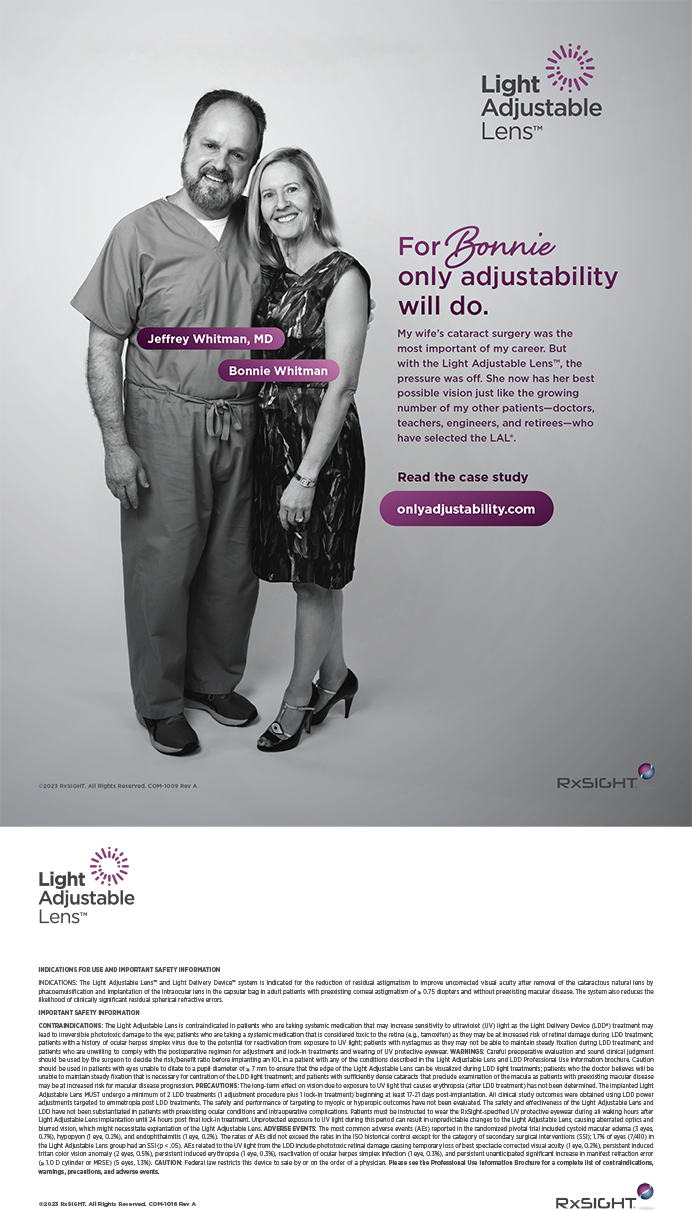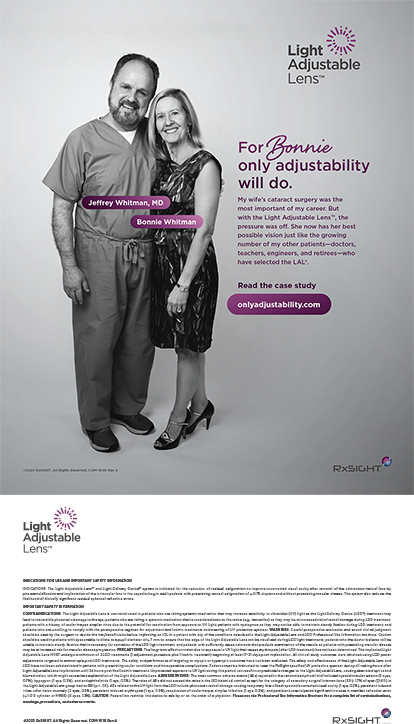


Electronic health records (EHRs) are getting a bad rap. Many of the advantages that should be obvious when using EHRs have been obscured by the complexity of meeting Meaningful Use (MU) in clinical practice. Fortunately, ambulatory surgery centers (ASCs) do not currently need to meet MU requirements, so use of the system in the ASC presents the perfect opportunity to recognize the inherent advantages without the downside.
As EHR use increases in clinics across the country, largely due to the mandates of MU, the broader use of EHRs in ASCs is receiving greater attention.
Fifteen years ago, we at Pankratz Eye Institute simultaneously implemented EHRs in our clinic and ASC. Because ours was a new business, we never had to endure transitioning from paper to electronic charts. That fact and the 10-plus years of using EHRs before MU make our experience unique. It allows us to share a different perspective with practices that are considering transitioning to EHRs today with the goal of improving efficiency and the patients’ experience. Here are some pros and cons to consider.
PROS
Space
There are many distinct advantages of using EHRs in an ASC, the first of which is space. When Michael J. Pankratz, MD, envisioned opening his new practice in Columbus, Indiana, in late 1999, he did not plan on having an ASC. He had already spoken to the real estate developer about a location for his practice, and the allotted space was about 3,000 square feet—not big enough for the ASC we ultimately decided to include.
In short, we were able to add about 1,300 square feet to the building to squeeze in the ASC, but everything had to be compressed (or, in the case of chart storage, eliminated). ASC records must be kept virtually forever, which makes safe management for record keeping vital, especially when those records become voluminous. EHRs eliminate the need for the physical space required to store paper records. We moved to a larger facility in 2005 but still do not have a chart storage room.
Speed and Timeliness
On the day of surgery, our patients move through the ASC in about an hour. This includes check-in, preoperative management, the surgical procedure, recovery, and discharge. One of the reasons these processes can be accomplished in such a short time is because the receptionist, nurses, and OR staff all have the ability to access the patient’s chart without having to chase a piece of paper through the ASC. The EHR system allows multiple locations and individuals to have virtually simultaneous access to the patient’s chart for everything from scheduling and clinical care to billing and insurance claims processing.
Our ASC and clinic are the same legal entity, which allows us to avoid duplication of the demographic parts of our database. Our system manages both our ASC’s and clinic’s medical and financial records in one system, and we can move patients from the clinic to the ASC without significant duplicate data entry, making for a smoother transition.
Flexibility
Our practice uses the ManagementPlus EHR, which offers great flexibility in form design. One of the advantages of starting a new practice at the same time as starting a new EHR system is that, because we were not busy when we first opened our doors in 2000, we had time to develop our forms instead of having to adapt to existing ones. Based on our experience designing forms to fit our processes, we can now rearrange them to suit our needs if our process changes. That flexibility has been paramount to our success.
Focus on the Patient/Accountability
Our EHR system has allowed us to develop our forms in such a way that the EHR is a tool for our use rather than the focus of our examination/procedure. Real-time access to medical charts allows us to focus on the patient in front of us during the examination process and to thoughtfully prepare for surgery. It makes our care more personal.
At the same time, our software is designed so that the users are held accountable for thoroughly completing patients’ records. If a required field has not been completed, the software does not allow the user to move on to the next screen. Those reminders help ensure that documentation is complete, and they eliminate any tendency we have to act habitually as we provide care without appropriately documenting the care we provide. If we do a great job of providing the care but do not document what we have done, the job is not finished. Regulators and attorneys only know it has been done when the paperwork is complete.
We recommend thinking of the forms/record as notes prepared for a speech: those notes keep us on track, prevent us from leaving out something important, and encourage us to do a more thorough job.
Customized Reporting
EHRs allow us to run customized reporting from the data we collect. There are numerous examples where customized reporting could be valuable such as
- designing reports to determine the percentage of our patients who receive a particular medication. With paper records, that process would involve reviewing hundreds of charts for specific notations. This feature is certainly useful in the case of a product recall.
- searching for patients with commonalities such as the same scrub technician in the same OR on the same surgery day or days
- doing data searches to identify trends like the percentage of postcataract surgery patients requiring YAG laser treatment
- monitoring outcomes related to specific treatment modalities like the effects different pre- and postoperative drop regimens have on healing and visual improvement after surgery
There are many other possibilities.
Modified Requirements
The Centers for Medicare & Medicaid Services and local and state ASC licensing agencies often demand that we modify our record keeping to meet their requirements. For example, we are facing the switch to the International Statistical Classification of Diseases 10 on October 1 of this year. EHR software makes it dramatically easier to conform to the demands placed upon us as the requirements change. At times, the alterations necessary to meet those requirements can be accomplished by revision of the software at the vendor level. Other times, the changes happen locally and internally with the modification of forms.
Electronic documentation allows for more data capture than an 8½ x 11-inch sheet of paper allows, and this can be advantageous. The complexities of medical documentation required today make the automated processes possible in the EHR invaluable. A drop-down list to choose from or extended explanatory verbiage that can be added with a single keystroke can be real lifesavers when it comes to meeting the regulatory requirements.
CONS
Lengthy Form-Design Process
There is no doubt that designing effective electronic forms is harder than designing paper forms. The process can be time-consuming. The EHR vendor may be able to assist practices with the form-design process or may have standardized forms for them to use. Because ManagementPlus focuses on ophthalmology, the company employs a group of certified ophthalmic technicians who have created ophthalmology-specific standard forms or can offer assistance with form design. This vendor also has many clients who have been happy to share with us the ideas they have developed for use in their own practices.
One of the most interesting events we have had the opportunity to participate in over the years is the annual ManagementPlus User Group Meeting held each fall in Park City, Utah. Attendees have an EHR “showdown” in which they compete live to demonstrate ways their practices have solved problems using the EHR system. The variety of problems and solutions is seemingly endless, and the event is a great learning experience.
Costs
As a startup company in 2000, it certainly would not have cost as much for us to design a paper chart as it did to go paperless. During the past 15 years, we have invested over $845,000 in hardware, software, and computer maintenance and information technology consulting to have EHR systems in our practice and ASC. There is no doubt that EHRs can be expensive, but the cost also includes our practice management system, which is fully integrated (practices may already be incurring a significant percentage of the computing cost associated with EHRs).
Although we have had to replace hardware to increase computer speed and file storage capacity, which has contributed to our costs over time, our need to spend money on those changes has decreased over the years due to technological advances. Both the hardware and software have improved, and the cost per gigabyte of storage has decreased dramatically since 2000. There are options today that did not exist 15 years ago (like cloud storage and programming) and will reduce the cost even more over time.
Another cost consideration is staff training when implementing EHRs. The calculation of that cost must include some decrease in productivity at the front end, but we feel that, as the workforce gains experience with EHRs, the ASC tends to be more efficient than paper charts allow.
In terms of cost, it is important to recall that space costs money and to remember all the real estate no longer needed for charts.
CONCLUSION
Whether in a clinic or an ASC, the transition to EHRs from paper charts may be difficult. It is not easy to give up tried-and-true methods, but the adoption of EHRs has proven itself in our setting. We cannot say whether there will ever be MU for ASCs, as defined by governmental mandates, but there is no doubt that the use of EHRs in our practice and ASC has been meaningful for us. n
Larry Gardner, MBA
• executive director of Pankratz Eye Institute, Columbus, Indiana
• lgardner@pankratzeye.com
• financial interest: none acknowledged
Karen Orisich, COT
• clinic director at Pankratz Eye Institute, Columbus, Indiana
• korisich@pankratzeye.com
• financial interest: none acknowledged
Brenda Richardson, BSN
• ASC director of Pankratz Eye Institute, Columbus, Indiana
• brichardson@pankratzeye.com
• financial interest: none acknowledged


